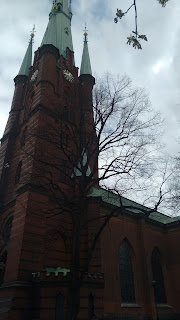ASSISTED
LIVING in Sweden
|from an
exchange of ideas|
On one of our very first study visits during our sojourn in
Stockholm, we were welcomed into a well maintained house with
immaculate decor in a suburb of the Botkyrka commune. This was one of
the many units set up for “Assisted Living” for Persons with
Disabilities, as the revolutionary new system adapted by Sweden is
named. Starting with a pilot project in ’87, this grew to be an
incredibly well managed system to normalise, to whatever extent
possible, the lives of the differently abled.
With an extensive mention in the Social Services
act and the LSS (Act for persons with Certain Functional
Impairments), there seems to be a great amount of research and
expertise that has gone into the formulation of this policy. The
guiding idea behind assisted living was that it should
promote
equality in living conditions and full participation in community
life for those (with significant and permanent impairments). The
objective is to make it possible for the individual in question to
live as others do. This is based on respect for an individual’s
right to self-determination and privacy.
The residence we
visited housed six persons, with three assistants, not all of whom
work every day. They spoke to us about how they go about assisting
the residents, and the things they do to help them be as independent
as they can. Sweden, unlike our own country, has a highly
individualistic society – with great importance being placed on
independence and self-sufficiency. Children move out by 18-23 years
of age, but for persons with disability, this would not be
practically possible before. And consequently, most would have no
choice but to be institutionalised, or if the family continued to
house them, they’d invariably feel like an immense burden. They did
not, then, feel respected by the community, leaving them continuously
conscious of contempt from the apparently more capable counterparts.
This was a vicious cycle which researchers and policy makers seemed
to have realised, and very effectively overturned. We also got to
know that just like everyone else, the persons with disabilities go
to work daily. There are ‘daily activity centres’ set up for
this, where the persons with relatively severe disabilities receive
therapy and sensory-motor training, and the ones who can, work on
making a variety of items and so on. The ‘work’ is thus what they
can do to the best of their ability, and self-improvement is
considered work too. Thoughtful, is it not?
However, as
intelligent as it is, it seems as though the emergence of a similar
setup is not even close in the line of vision for our own country,
for more reasons than one. Firstly, it is a huge cost on the economy.
In Sweden, it is estimated to come upto 5 billion USD per annum, and
together with the benefits and social services for these individuals,
it takes up about 1% of the GNP and 2% of public expenditure.
Definitely not feasible for a country in an awkward, off-balance
middle-stage of developing that ours is. It also requires quite a lot
of technological support, and well-trained staff. In Sweden,
cuurently, about 20,000 people receive personal assistance, and this
is 0.2% of their fairly low population. In India, if the criteria to
provide it were maintained, the number of beneficiaries would shoot
up exponentially, further extending the financial requirements. But
one thing to remember is that the concept grew out of their societal
and cultural norms, to allow persons with disabilities to live the
same way as other adults. Indian society is nowhere near as
individualistic. For most part, anyway. Notwithstanding the new age
metropolitan lifestyle among younger urban circles, much of the
Indian population lives with very collective, community-based values.
Moving out at twenty is not a norm here as it is in Sweden – where,
failing to do so would definitely cause someone to be extremely
conscious of their incapacity to construct and sustain their own
separate life, making them feel like a burden on their parents. All
the same, that does not imply that it is not required here, it simply
means that its implementation and structural details would have to be
a little different here. It simply would need to be tweaked in
places, modified to suit the Indian style of living and the
group-based culture typical of the eastern countries.
As of now, Goa
too is working hard for persons with disabilities. We have
specialised units, mostly private, providing guidance and assistance
and catering to a variety of therapeutic needs, but this is focused
on persons still in the developmental age. The state, as of now,
seems to be concentrating its efforts mostly on the education of
children with special needs, and on general disability-friendly
measures that would reduce the obstacles in day-to-day public life of
the disabled. For the adult side, the state has reservations in
public employment, lifetime pension benefits and such, but we are a
long way off from building a uniform, national framework for
independent living of these adult individuals with state support.



















